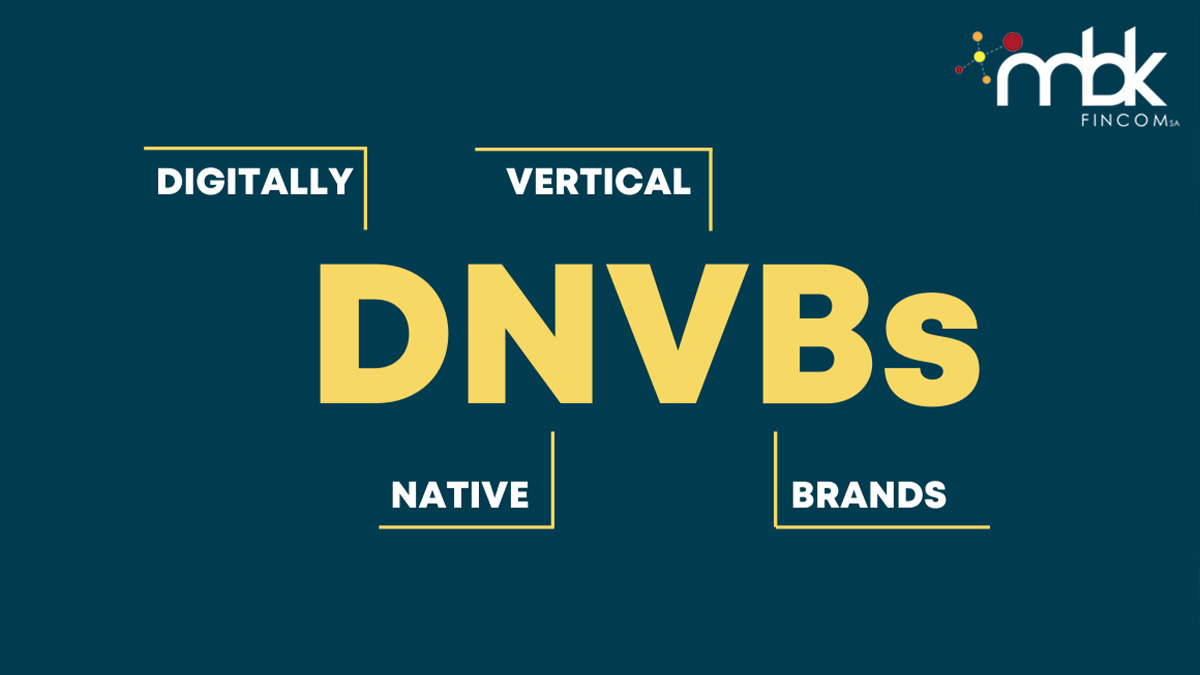Over the last 20 years, the main pole of the market has slowly changed its focus. From the uniqueness and centrality of offline retail to the majority market takeover of digital brands. How did small stoandrefronts manage to impose themselves on large physical brands? MBK attempts to explain this by examining some of its brands and the ProduceShop phenomenon.
By Digital Native Vertical Brand (DNVB) we mean all those brands that in recent years were born thanks to and within digital dynamics; they differ from classic retail brands, or traditional brands, as their presence is exclusively online. They have no physical shops (except for a few pop-up stores or temporary stands) but, since they take care of their entire production chain (production-distribution-publicisation), they choose to be present only as a web reality.
However, the fact that they are completely digital does not mean they ‘do not exist’; the decision to relocate everything other than the product to servers has a precise purpose. If an offline retailer incurs substantial expenses in the physical setting up of the shop window (in the sense of a sales location), the DNVBs can exclude this cost, along with intermediary expenses, from their budget.
This net differentiation has meant that, over time, this type of business has increased in number, slowly taking over from the point of view of market authority.
DNVB: a constantly developing phenomenon
The definition of Digital(ly) Native Vertical Brands comes straight from 2007 and from the words of Andy Dunn, founder of Bonobos, a precursor of DNVB and e-commerce menswear. In his idea, and in what has become reality over time, this type of completely digital reality, born exclusively on the web, differs from the big giants like Amazon in two fundamental factors: control of the supply chain and communication strategies.
We are talking about brands that normally deal with just one product category or, even more commonly, just one product or product type. By redirecting their commercial strategy to such a well-considered target group, they can concentrate their control on the entire production chain, completely avoiding intermediaries; from production to transport, from distribution to marketing, everything is managed by the brand. This not only reduces costs exponentially, but the level of customization that the brand can implement is limitless to say the least. By completely managing the distribution of their products, they can identify them with the brand itself, generating a communication strategy that controls two fundamental marketing constants:
- the storytelling of the brand itself and its originality
- the reception and analysis of consumer data.
These are even easier to dominate if we consider that their entire communication strategy with users and consumers (never confuse the two categories) is based on a high level of intimacy, also linked to the target group that they fill.
The communication channels are also changing: while classic retail maintains its consistency in the advertising media chosen (audio-video advertising, billboards), DNVB’s marketing strategies are almost exclusively based on digital dynamics; this makes them in line with current research and consumption patterns, increasing conversion rates and, consequently, turnover.

Advantages and benefits of an DNVB
The advantages of these v-commerce (another term they are known with) are mostly in the type of communication they decide to set up.
Having absolute freedom on the management of the product (which can be created in house or managed by trusted third parties), the level of customization, both corporate and customer, is virtually infinite; this is one of the strengths of the DNVBs, namely the possibility of providing tailor-made or at least highly customizable services.
But the real strength lies in their way of communicating with the customer; by establishing a one-to-one dialogue they automatically set the relationship on an extremely personal level, which makes the customer feel followed and an integral part of the company ecosystem. The focus on User Experience becomes basic on their sites, the focus on Customer Experience a priority. This is already a huge point of differentiation from the “old school” of e-commerce, where customer care and the customer journey, however attentive, are now standardized to ensure technical autonomy in extremely structured companies.
There are several examples of this completely new way of looking at the digital market; we are talking about brands moving in very different market sectors. We can cite “Everlane“, a clothing brand that focuses on absolute transparency; “Dollar Shave Club“, which relied on a subscription to an efficient delivery service; “Article” for furniture or “Brilliant Earth” for the luxury jewellery trade. Or the Italian “Lanieri” and “Velasca“, in the field of tailor-dressing and handcrafted footwear: a sector in which, until very recently, it was unthinkable to move out of the physical shop framework.
Effective communication and control of the production chain without intermediaries translate into a commercial margin that is almost double that of traditional web retailers (65% vs. 30%).
A sudden shift from eCommerce to Digital Brands
Although DNVBs are by definition born on the web, cases of e-commerce or even physical businesses switching to this type of phenomenon are not uncommon. On the other hand, the ability to update and improve is today the primary fuel in the world of online sales; if you cannot renew your catalogue, your value proposition, but also your image and the way you make yourself heard, you risk stagnation and, in time, disappearing from the market.
This is why, alongside the real Digital Natives, we find a whole series of Digital Reborn Brands [ndR], i.e. that group of e-commerce and digital retailers of the previous generation which, adapting to the dynamics of these new players, have decided to renew and redesign themselves.
The main changes, which then define the native characteristics of v-commerce, made by these DRBs are essentially
- Transparency
- Authenticity
- Optimised CX
- Verticality
All this transforms a simple customer into an ambassador, a loyal consumer who self-identifies with the brand.
At market level, more and more small businesses are managing to carve out ever larger slices of turnover, partly thanks to their digital innovation features. In some cases, this is forcing large established players in the retail market to acquire digital start-ups (e.g. Unilever and its billion-dollar acquisition of Dollar Shave Club) or to make a total makeover in order to compete in certain markets

MBK’s DNVB
MBK has also carefully studied the Digital Native market and ProduceShop together with its brands is the result.
Let’s hear what Matteo Bacchi, Procurement Manager of MBK Fincom and ProduceShop, has to say about this:
“We can’t exactly call ProduceShop a DNVB for one key reason: our catalogue is based on a directional offer, but not a category-killer. Over time, we have chosen to range from the point of view of the products we deal with, and this is one of the first reasons why we differ from the Natives.
What we have in common, however, apart from being born as a completely digital reality (indeed, unlike many DBs, we do not have temporary and pop-up stores), is the choice to focus on UX and transparent communication.
Having an IT and Development department in support of us, made up of eclectic and constantly innovative talents, together with an extremely active and productive Marketing Department, allows us to keep up with the trends in the sector and to constantly update our communication, to adapt it to the new ways and demands of the audience. This leads us to tell our story directly, bringing to the forefront not only our qualitative choices regarding the product, but many other realities; our commitment to environmental sustainability, our dedication to green issues and our choice of suppliers in line with our own vision.”
In conclusion
Although the market presence of Digital Native Vertical Brands can be measured quantitatively, we cannot predict the future of this type of reality.
Their rapid and inexorable rise has generated an overbearing and decisive reaction from many traditional companies and retailers, which could lead to two different conclusions: the birth of a third hybrid structure, such as ProduceShop, or the cancellation of one of the two in favour of the other.
Or, as can be predicted, communication channels will undergo a further shake-up; the way of selling and consuming will change once more, leaving a whole world of digital possibilities unexplored.
Sources:
- Corporate PR
- ProduceShop Development Department
- Produceshop Procurement Department (https://mbkfincom.com)
- Eurostat.eu
- DNVB Italy
- Guidance.com
- E-Commerce Nation
- Trading Economics
- Il Sole 24Ore


